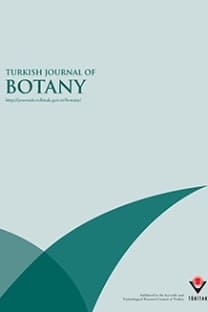Pollen morphology of sections Siphonomorpha and Lasiostemones of the genus Silene from Turkey
The pollen morphology of 16 taxa belonging to the sections Siphonomorpha Otth and Lasiostemones Boiss. from the genus Silene L. (Caryophyllaceae) was examined via scanning electron microscopy (SEM). Pollen types among all of the examined taxa were spheroidal; ornamentations were generally microechinate-microperforate (punctate), but perforate in Silene viridiflora L.; structures were mostly tectate but were observed to be semitectate only in S. viridiflora; the highest pore numbers were found in S. fruticosa L. and S. viridiflora; the lowest pore numbers were those of S. gigantea L. subsp. rhodopea (Janka) Greuter and S. marschallii C.A.Mey.; and interpore distance was greatest in S. gigantea subsp. rhodopea and smallest in S. amana Boiss. The widest perforation was observed in S. Viridiflora, whereas the lowest value was observed in S. olympica Boiss. As a result of these detailed examinations, some Silene species with significant taxonomic problems were reviewed in terms of palynology, and suggestions are provided about their positions. S. viridiflora was determined to be the taxon with the most different pollen morphology according to general characters. According to pore number and perforation, the most advanced taxon was S. Viridiflora, while the most primitive taxa were found to be S. olympica, S. gigantea subsp. rhodopea, and S. olympica.
Pollen morphology of sections Siphonomorpha and Lasiostemones of the genus Silene from Turkey
The pollen morphology of 16 taxa belonging to the sections Siphonomorpha Otth and Lasiostemones Boiss. from the genus Silene L. (Caryophyllaceae) was examined via scanning electron microscopy (SEM). Pollen types among all of the examined taxa were spheroidal; ornamentations were generally microechinate-microperforate (punctate), but perforate in Silene viridiflora L.; structures were mostly tectate but were observed to be semitectate only in S. viridiflora; the highest pore numbers were found in S. fruticosa L. and S. viridiflora; the lowest pore numbers were those of S. gigantea L. subsp. rhodopea (Janka) Greuter and S. marschallii C.A.Mey.; and interpore distance was greatest in S. gigantea subsp. rhodopea and smallest in S. amana Boiss. The widest perforation was observed in S. Viridiflora, whereas the lowest value was observed in S. olympica Boiss. As a result of these detailed examinations, some Silene species with significant taxonomic problems were reviewed in terms of palynology, and suggestions are provided about their positions. S. viridiflora was determined to be the taxon with the most different pollen morphology according to general characters. According to pore number and perforation, the most advanced taxon was S. Viridiflora, while the most primitive taxa were found to be S. olympica, S. gigantea subsp. rhodopea, and S. olympica.
